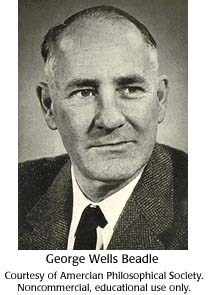Concept 16 One gene makes one protein.

 George Beadle had successful research careers in corn and Drosophila genetics, before starting the field of Neurospora research. George Beadle and Edward Tatum used Neurospora to prove that "one gene makes one protein." Tatum also had a role in starting bacterial genetics.
George Beadle had successful research careers in corn and Drosophila genetics, before starting the field of Neurospora research. George Beadle and Edward Tatum used Neurospora to prove that "one gene makes one protein." Tatum also had a role in starting bacterial genetics.
George Wells Beadle (1903-1989)

George Beadle, "Beets" to his friends, was born in Wahoo, Nebraska. His father was a farmer and had a 40-acre farm just outside Wahoo. Beadle's mother died when he was four, and Beadle, his brother, and his sister were raised by his father and housekeepers.
Beadle's father thought he might become a farmer. However, Beadle's high school science teacher encouraged him to go to college. Beadle graduated from the University of Nebraska College of Agriculture with a science degree in 1926, and stayed an extra year to finish a master's degree.
While working on his master's degree on the ecology of grasses, Beadle became interested in genetics. He applied to graduate school at Cornell University and, in 1927, joined R. A. Emerson's group to work on corn genetics. Emerson's group included Barbara McClintock who later helped Beadle figure out the chromosome number of Neurospora.
After he finished his Ph.D. in 1931, Beadle did post doctoral work in T. H. Morgan's newly established biology division at Caltech and then in Paris with Boris Ephrussi. Beadle worked with the "hot" genetics model of the day, Drosophila melanogaster. He published papers on crossing over and developed the technique of imaginal disc transplantation. Beadle, with Ephrussi, also published a 1937 paper on the interaction of genes in determining Drosophila eye color. Hints of the "one gene-one enzyme" hypothesis were in this paper. Beadle and Ephrussi alluded to genes making substances necessary for pigmentation and to mutations in the genes disrupting this process.
In 1937, Beadle teamed up with Edward Tatum at Stanford University to isolate and identify the eye color "substances." They were beaten by another group; however, this just convinced Beadle that they needed a simpler genetic system to study the question of gene action. He found it in Neurospora, and in 1940, Beadle converted his Drosophila lab into one set up to grow and culture Neurospora.
Beadle's plan to mutate Neurospora and test for nutritional deficiencies was sound; however, there was no guarantee of success. Beadle and Tatum agreed ahead of time only to test 5,000 cultures before giving up on the idea. They collected and stored over 1,000 irradiated cultures before they actually tested any of them. Success came with the 299th culture. Beadle and Tatum published their results in 1941 and shared the 1958 Nobel Prize in Physiology or Medicine.
Beadle was a popular and much admired boss. Enthusiastic, practical and funny, no job was too big or too small. He directed as well as did the experiments; he also took care of the lab by doing many of the small repairs and making some of the necessary equipment.
In 1945, Beadle accepted the Chair of the Division of Biology at Caltech, replacing T. H. Morgan who had died. From 1961 to 1968, Beadle served as the President of the University of Chicago, and was able to bolster and strengthen the university's image. After retirement in 1969, Beadle took up research again to try and determine the origin of maize. In 1981, Beadle developed Alzheimer disease. He died in 1989, bringing a distinguished career to an end.


Three years after the Neurospora paper, George Beadle became aware of the work Archibald Garrod did on alkaptonuria in 1902. Beadle saw the similarities and credited Garrod with being the first to work on the "one gene/one protein" theory.

In 1902, Archibald Garrod proposed that diseases are "inborn errors of metabolism." Why wasn't Garrods' theory well-known and accepted in 1902?
 DNA and proteins are key molecules of the cell nucleus.
DNA and proteins are key molecules of the cell nucleus. One gene makes one protein.
One gene makes one protein. A gene is made of DNA.
A gene is made of DNA. Bacteria and viruses have DNA too.
Bacteria and viruses have DNA too. The DNA molecule is shaped like a twisted ladder.
The DNA molecule is shaped like a twisted ladder. A half DNA ladder is a template for copying the whole.
A half DNA ladder is a template for copying the whole. RNA is an intermediary between DNA and protein.
RNA is an intermediary between DNA and protein. DNA words are three letters long.
DNA words are three letters long. A gene is a discrete sequence of DNA nucleotides.
A gene is a discrete sequence of DNA nucleotides. The RNA message is sometimes edited.
The RNA message is sometimes edited. Some viruses store genetic information in RNA.
Some viruses store genetic information in RNA. RNA was the first genetic molecule.
RNA was the first genetic molecule. Mutations are changes in genetic information.
Mutations are changes in genetic information. Some types of mutations are automatically repaired.
Some types of mutations are automatically repaired.